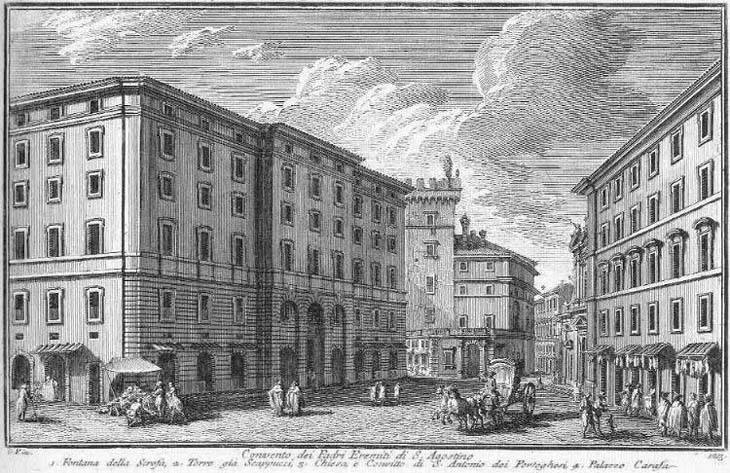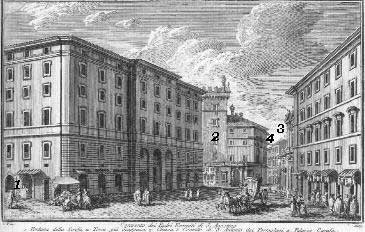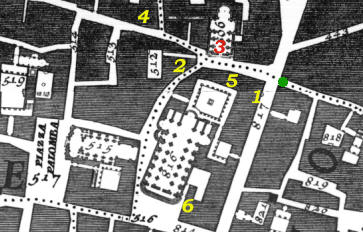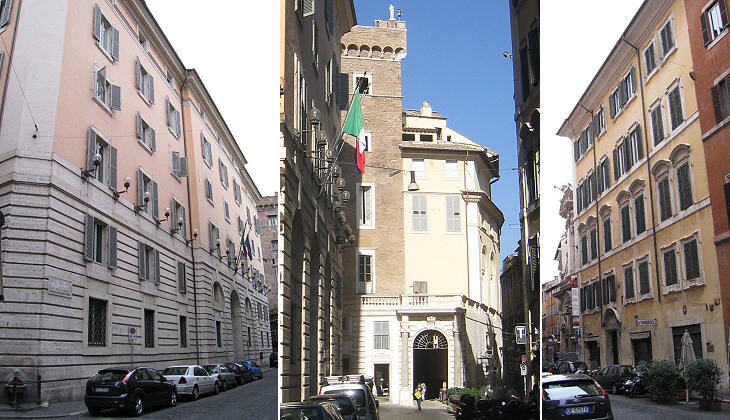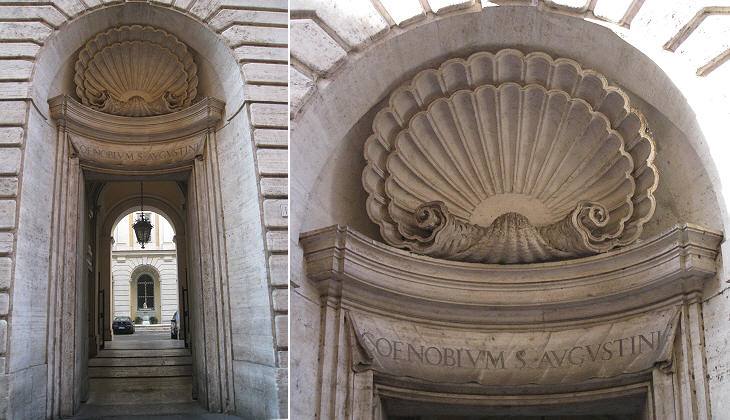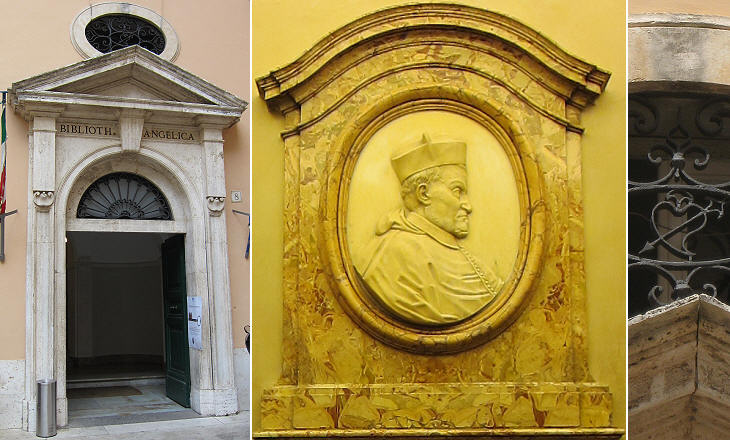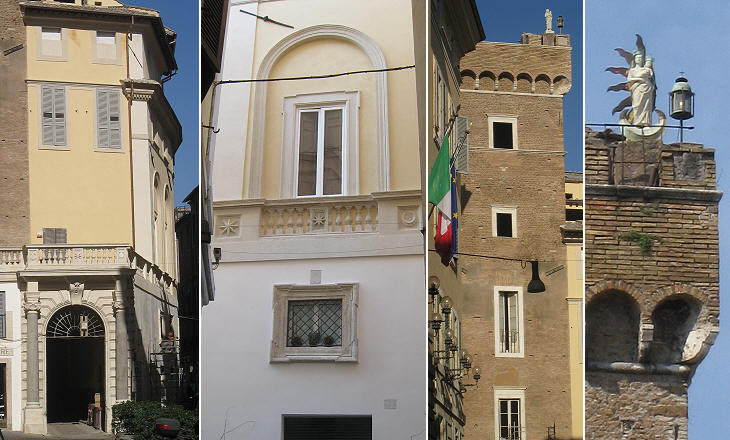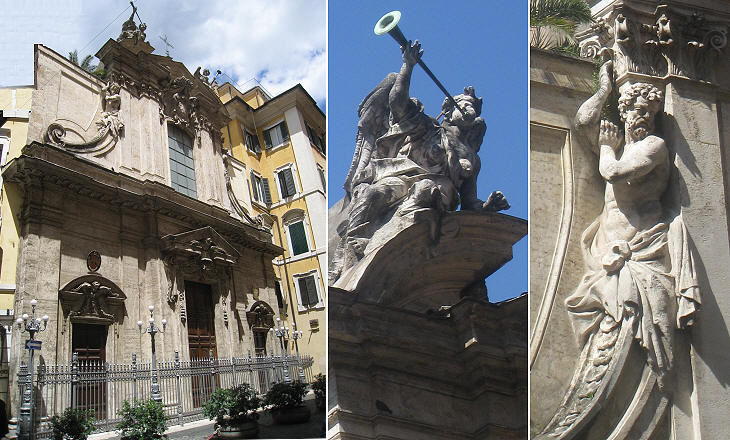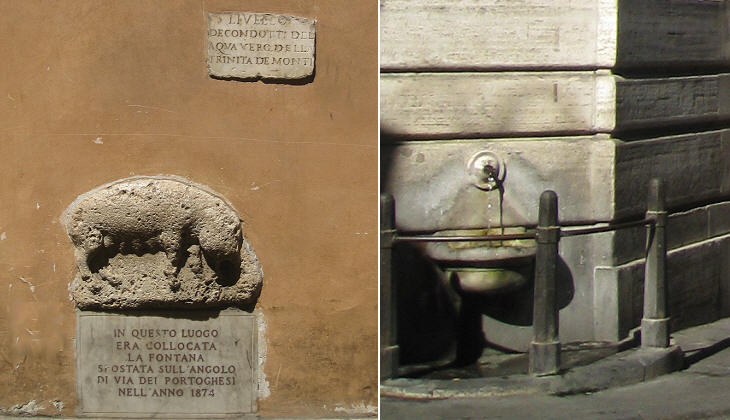  What's New! Detailed Sitemap All images © by Roberto Piperno, owner of the domain. Write to romapip@quipo.it. Text edited by Rosamie Moore. Page revised in October 2010. | Convento di S. Agostino (Book 7) (Map C2) (Day 4) (View C6) (Rione Sant'Eustachio), (Rione Campo Marzio) and (Rione Ponte)
In this page:
In 1756, when Giuseppe Vasi published this etching, the redesign of the Augustinian monastery by Luigi Vanvitelli was not yet completed and it is possible that Vasi based his view on projects, rather than on the actual building because some details, such as the main portal and the shops, do not correspond to the current aspect of the monastery. The view shows a rather unknown, but picturesque corner of Rome with buildings of different periods and styles: to the left the severe design of the monastery, at the centre a medieval tower which was incorporated into a late XVIth century palace and to the right the baroque fašade of S. Antonio dei Portoghesi. The view is taken from the green dot in the small 1748 map here below. In the description below the plate Vasi made reference to: 1) Fontana della Scrofa; 2) Torre Scapucci; 3) S. Antonio dei Portoghesi; 4) Palazzo Carafa, a building void of interest. The small map shows also 5) Convento di S. Agostino; 6) Biblioteca Angelica. The dotted line in the small map delineates the borders among Rione Ponte (left), Sant'Eustachio (lower part of the map) and Rione Campo Marzio (upper right quarter).
Today
Only very minor changes have occurred with the exception of the shops in the monastery building; the small fountain was relocated to the corner of the street, but the ancient relief portraying a sow (It. scrofa) was left in its original location. Convento di S. Agostino
The Augustinian order was not founded by St. Augustine of Hippo, perhaps the most important theologian of the Western Roman Empire, but it developed in the XIIIth century with the help of the popes, who wanted to counterbalance the growing influence of Franciscans and Dominicans. The Augustinians adopted a very severe lifestyle and they expressed it also by limiting the decoration of their new monastery to the main portal. Today the building belongs to the Italian State and it houses Avvocatura Generale dello Stato, the body of lawyers who defend public institutions in court.
In 1614 Angelo Rocca, an Augustinian theologian, opened the first public library in Rome in a house adjoining the monastery; in 1659 Pope Alexander VII asked Francesco Borromini to design an appropriate building to house the library. Biblioteca Angelica was particularly rich in books dealing with the views expressed by Cornelius Jansen, a Belgian theologian, whose main work was dedicated to reviving the importance of St. Augustine's teachings. The Jesuits strongly opposed Jansen and the library had many anti-Jesuit texts. In 1871 the property of the library passed to the Italian State.
Mr. Thompson took me into the Via Portoghese, and showed me an old palace, above which rose--not a very customary feature of the architecture of Rome--a tall, battlemented tower. At one angle of the tower we saw a shrine of the Virgin, with a lamp, and all the appendages of those numerous shrines which we see at the street corners, and in hundreds of places about the city. Three or four centuries ago this palace was inhabited by a nobleman who had an only son, and a large, pet monkey, and one day the monkey caught the infant up and clambered to this lofty turret, and sat there with him in his arms grinning and chattering like the Devil himself. The father was in despair, but was afraid to pursue the monkey lest he should fling down the child from the height of the tower and make his escape. At last he vowed that if the boy were safely restored to him he would build a shrine at the summit of the tower, and cause it to be kept as a sacred place forever. By and by the monkey came down and deposited the child on the ground; the father fulfilled his vow, built the shrine, and made it obligatory on all future possessors of the palace to keep the lamp burning before it. Centuries have passed, the property has changed hands; but still there is the shrine on the giddy top of the tower, far aloft over the street, on the very same spot where the monkey sat, and there burns the lamp, in memory of the father's vow. Nathaniel Hawthorne - French and Italian Notebooks - 1883. The note by Hawthorne explains why the tower is known as Torre della Scimmia (monkey); the tower was most likely part of the Augustinian monastery; it was acquired by the Scapucci, who built a small late Renaissance palace around it. S. Antonio dei Portoghesi
The church was founded in 1440 by Antonio Martinez de Chavez, a Portuguese cardinal, together with the adjoining hospital; during the XVIth century the Portuguese brotherhood in Rome acquired several buildings near the church and in 1624 it decided to build a new larger church which was designed by Martino Longhi. It is dedicated to St. Anthony of Lisbon, who is also known as St. Anthony of Padua. The addition of a large coat of arms of the Braganša royal family occurred after 1640, when Portugal returned to full independence (between 1580 and 1640 the country was linked to Spain by a personal union and the Habsburg King of Spain was also the King of Portugal). The construction of the church was completed by Carlo Rainaldi and Cristoforo Schor (click here for a list of national churches in Rome); you can see its organ in a separate page. Fontana della Scrofa
This tiny fountain was most likely built at the time of Pope Gregory XIII when conduits brought Acqua Vergine to this part of Rome. The relief gives its name to Via della Scrofa, the southern section of Via di Ripetta. Excerpts from Giuseppe Vasi 1761 Itinerary related to this page:
Next plate in Book 7: Chiesa di S. Onofrio Next step in Day 4 itinerary: Collegio Germanico Next step in your tour of Rione Sant'Eustachio: Palazzo Baldassini Next step in your tour of Rione Ponte: Collegio Germanico Next step in your tour of Rione Campo Marzio: Porto di Ripetta |
